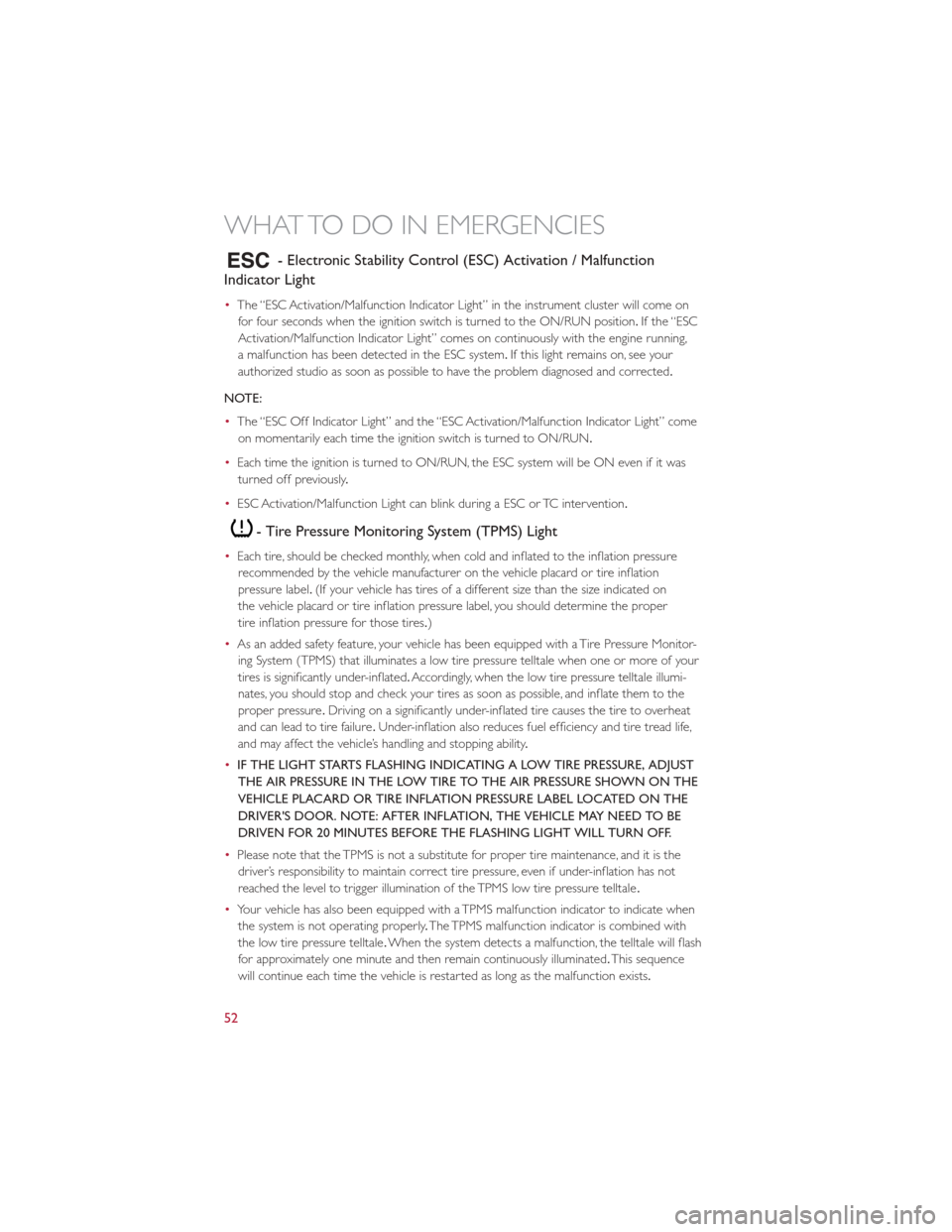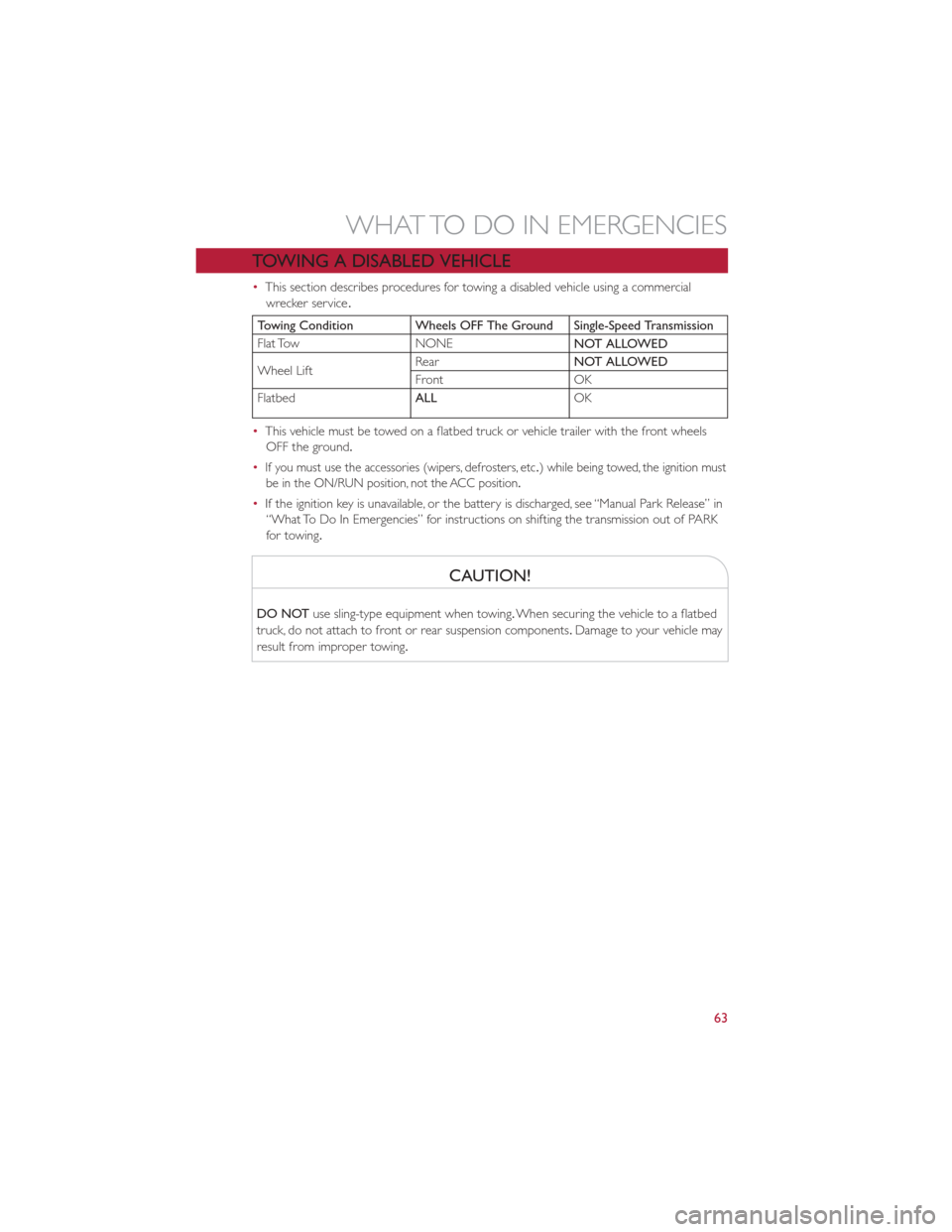run flat FIAT 500E 2013 2.G User Guide
[x] Cancel search | Manufacturer: FIAT, Model Year: 2013, Model line: 500E, Model: FIAT 500E 2013 2.GPages: 84, PDF Size: 1.56 MB
Page 54 of 84

- Electronic Stability Control (ESC) Activation / Malfunction
Indicator Light
• The “ESC Activation/Malfunction Indicator Light” in the instrument cluster will come on
for four seconds when the ignition switch is turned to the ON/RUN position. If the “ESC
Activation/Malfunction Indicator Light” comes on continuously with the engine running,
a malfunction has been detected in the ESC system. If this light remains on, see your
authorized studio as soon as possible to have the problem diagnosed and corrected.
NOTE:
• The “ESC Off Indicator Light” and the “ESC Activation/Malfunction Indicator Light” come
on momentarily each time the ignition switch is turned to ON/RUN.
• Each time the ignition is turned to ON/RUN, the ESC system will be ON even if it was
turned off previously .
• ESC Activation/Malfunction Light can blink during a ESC or TC intervention.
- Tire Pressure Monitoring System (TPMS) Light
•Each tire, should be checked monthly, when cold and inflated to the inflation pressure
recommended by the vehicle manufacturer on the vehicle placard or tire inflation
pressure label. (If your vehicle has tires of a different size than the size indicated on
the vehicle placard or tire inflation pressure label, you should determine the proper
tire inflation pressure for those tires.)
• As an added safety feature, your vehicle has been equipped with a Tire Pressure Monitor-
ing System (TPMS) that illuminates a low tire pressure telltale when one or more of your
tires is significantly under-inflated. Accordingly, when the low tire pressure telltale illumi-
nates, you should stop and check your tires as soon as possible, and inflate them to the
proper pressure .Driving on a significantly under-inflated tire causes the tire to overheat
and can lead to tire failure .Under-inflation also reduces fuel efficiency and tire tread life,
and may affect the vehicle’s handling and stopping ability .
• IF THE LIGHT STARTS FLASHING INDICATING A LOW TIRE PRESSURE, ADJUST
THE AIR PRESSURE IN THE LOW TIRE TO THE AIR PRESSURE SHOWN ON THE
VEHICLE PLACARD OR TIRE INFLATION PRESSURE LABEL LOCATED ON THE
DRIVER'S DOOR. NOTE: AFTER INFLATION, THE VEHICLE MAY NEED TO BE
DRIVEN FOR 20 MINUTES BEFORE THE FLASHING LIGHT WILL TURN OFF.
• Please note that the TPMS is not a substitute for proper tire maintenance, and it is the
driver’s responsibility to maintain correct tire pressure, even if under-inflation has not
reached the level to trigger illumination of the TPMS low tire pressure telltale .
• Your vehicle has also been equipped with a TPMS malfunction indicator to indicate when
the system is not operating properly .The TPMS malfunction indicator is combined with
the low tire pressure telltale .When the system detects a malfunction, the telltale will flash
for approximately one minute and then remain continuously illuminated. This sequence
will continue each time the vehicle is restarted as long as the malfunction exists .
WHAT TO DO IN EMERGENCIES
52
Page 58 of 84

Sealing A Tire With TIREFIT
(A) Whenever You Stop To Use TIREFIT:
1.Pull over to a safe location and turn on the vehicle’s Hazard Warning flashers.
2. Verify that the valve stem (on the wheel with the deflated tire) is in a position that is
near to the ground. This will allow the TIREFIT Hoses (6) and (7) to reach the valve stem
and keep the TIREFIT kit flat on the ground. This will provide the best positioning of the
kit when injecting the sealant into the deflated tire and running the air pump .Move the
vehicle as necessary to place the valve stem in this position before proceeding.
3. Place the transmission in PARK (auto transmission) or in Gear (manual transmission) and
cycle the ignition to the OFF position.
4. Set the parking brake .
(B) Setting Up To Use TIREFIT:
1.Turn the Mode Select Knob (5) to the Sealant Mode position.
2.
Uncoil the Sealant Hose (6) and then remove the cap from the fitting at the end of the hose .
3.Place the TIREFIT kit flat on the ground next to the deflated tire .
4. Remove the cap from the valve stem and then screw the fitting at the end of the Sealant
Hose (6) onto the valve stem.
5. Uncoil the Power Plug (8) and insert the plug into the vehicle’s 12 Volt power outlet.
6. Do not remove foreign objects (e .g., screws or nails) from the tire.
(C) Injecting TIREFIT Sealant Into The Deflated Tire:
•Always start the engine before turning ON the TIREFIT kit.
• After pressing the Power Button (4), the sealant (white fluid) will flow from the Sealant
Bottle (1) through the Sealant Hose (6) and into the tire .
NOTE:
Sealant may leak out through the puncture in the tire .
• If the sealant (white fluid) does not flow within0–10seconds through the Sealant
Hose (6):
1. Press the Power Button (4) to turn Off the TIREFIT kit. Disconnect the Sealant Hose (6)
from the valve stem. Make sure the valve stem is free of debris. Reconnect the Sealant
Hose (6) to the valve stem. Check that the Mode Select Knob (5) is in the Sealant Mode
position and not Air Mode .Press the Power Button (4) to turn On the TIREFIT kit.
2.
Connect the Power Plug (8) to a different 12 Volt power outlet in your vehicle or another
vehicle, if available .Make sure the engine is running before turning ON the TIREFIT kit .
3.The Sealant Bottle (1) may be empty due to previous use .Call for assistance .
WHAT TO DO IN EMERGENCIES
56
Page 65 of 84

TOWING A DISABLED VEHICLE
•This section describes procedures for towing a disabled vehicle using a commercial
wrecker service .
Towing Condition Wheels OFF The Ground Single-Speed Transmission
Flat Tow NONE
NOT ALLOWED
Wheel Lift Rear
NOT ALLOWED
Front OK
Flatbed ALL OK
• This vehicle must be towed on a flatbed truck or vehicle trailer with the front wheels
OFF the ground.
•
If you must use the accessories (wipers, defrosters, etc .) while being towed, the ignition must
be in the ON/RUN position, not the ACC position .
•If the ignition key is unavailable, or the battery is discharged, see “Manual Park Release” in
“What To Do In Emergencies” for instructions on shifting the transmission out of PARK
for towing.
CAUTION!
DO NOT use sling-type equipment when towing. When securing the vehicle to a flatbed
truck, do not attach to front or rear suspension components .Damage to your vehicle may
result from improper towing.
WHAT TO DO IN EMERGENCIES
63